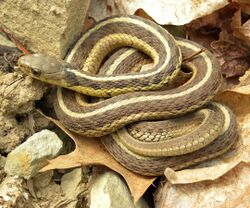Biology:Eastern garter snake
| Eastern garter snake | |
|---|---|

| |
| Scientific classification | |
| Domain: | Eukaryota |
| Kingdom: | Animalia |
| Phylum: | Chordata |
| Class: | Reptilia |
| Order: | Squamata |
| Suborder: | Serpentes |
| Family: | Colubridae |
| Genus: | Thamnophis |
| Species: | |
| Subspecies: | T. s. sirtalis
|
| Trinomial name | |
| Thamnophis sirtalis sirtalis (Linnaeus, 1758)
| |
The eastern garter snake (Thamnophis sirtalis sirtalis) is a medium-sized snake indigenous to North America.
Taxonomy and etymology
The scientific name Thamnophis sirtalis sirtalis is a combination of Ancient Greek and New Latin that means "bush snake that looks like a garter strap on". The generic name Thamnophis is derived from the Greek "thamnos" (bush) and "ophis" (snake) and the specific name sirtalis is derived from the New Latin "siratalis" (like a garter), a reference to the snake's color pattern resembling a striped garter strap.[2]
Description
Eastern garter snakes average between 46–66 cm (18–26 in) long. The largest recorded length was 124 cm (48.7 in) long. Females are typically larger than males. They are either a greenish, brown, or black color and have a distinct yellow or white stripe.
Reproduction
Eastern garter snakes are ovoviviparous, giving birth to live young. Many males may try to mate with one female, resulting in a "breeding ball". The young are 13–23 cm (5–9 in) long at birth.
Distribution and habitat
The eastern garter snake has a wide range across eastern North America, as far north as southern Ontario and Quebec to the Gulf of Mexico in the south, along the eastern shores of America to the Mississippi River.[3] In New England, the snake is described as the "most widespread and ubiquitous" serpent, from wilderness to urban environments and from sea level to high elevations.[2]
The eastern garter snake will live in a variety of environments, with a preference for grassy or shrubby fields, including abandoned farmland, outbuildings and trash dumps.[2] In particular the snake likes to inhabit stone walls that separate the forest from fields. It is also found along moist habitats such as lakes, rivers, streams, swamps, bogs, ponds, drainage ditches, and quarries. Snakes are present in urban environments in habitats that include "city parks, cemeteries and suburban yards and gardens".[2] Eastern garter snakes like to conceal themselves under logs, stones and other debris that allow them to bask in the sunlight and quickly seek refuge from predators. Krulikowski notes that "[o]ld poultry farms with discarded sheet-metal incubation trays provide warm, moist hiding places."[2]
Feeding
Eastern garter snakes mostly eat frogs, toads, slugs, and worms, but they will eat almost anything they can overpower.
The eastern garter snake is broadly considered non-venomous. Garter snakes do have a Duvernoy's gland, and the secretion from the gland may be chewed into prey during bites. The secretion is noted to cause hemorrhaging in mice and has produced non-allergic symptoms in at least one bite on a human.[4][5][6]
Predator avoidance
The eastern garter snake is known to flatten its head and anterior body and strike forward if it is bothered. Juveniles have been observed to engage in this behavior and strike at such a force that they leave the ground entirely. Adults also will spray musk from glands in their tail, and sometimes defecate to discourage predators. [7] Snakes with higher body temperatures are more likely to flee from predators.[8]
References
- ↑ NatureServe (1 September 2023). "Thamnophis sirtalis sirtalis". Arlington, Virginia: NatureServe. https://explorer.natureserve.org/Taxon/ELEMENT_GLOBAL.2.100874/Thamnophis_sirtalis_sirtalis.
- ↑ 2.0 2.1 2.2 2.3 2.4 Krulikowski, Linda (2004). Snakes of New England. Lebon Press. pp. 72–84. ISBN 0976431602.
- ↑ "Thamnophis sirtalis sirtalis (Linnaeus, 1758) - Eastern Garter Snake". wcsu.edu. http://people.wcsu.edu/pinout/herpetology/tsirtalis/frame2.htm. Retrieved 14 May 2014.
- ↑ Hayes, William K.; Hayes, Floyd E. (1985). "Human envenomation from the bite of the eastern garter snake, Thamnophis s. sirtalis (Serpentes: Colubridae)". Toxicon 23 (4): 719–721. doi:10.1016/0041-0101(85)90376-9. ISSN 0041-0101. PMID 4060180. http://dx.doi.org/10.1016/0041-0101(85)90376-9.
- ↑ Vest, Darwin K. (1981). "The toxic Duvernoy's secretion of the wandering garter snake, Thamnophis elegans vagrans". Toxicon 19 (6): 831–839. doi:10.1016/0041-0101(81)90079-9. ISSN 0041-0101. PMID 7336444. http://dx.doi.org/10.1016/0041-0101(81)90079-9.
- ↑ Gomez, H. F.; Davis, M.; Phillips, S.; McKinney, P.; Brent, J. (1994). "Human envenomation from a wandering garter snake". Annals of Emergency Medicine 23 (5): 1119–1122. doi:10.1016/s0196-0644(94)70113-x. ISSN 0196-0644. PMID 8185110. https://pubmed.ncbi.nlm.nih.gov/8185110.
- ↑ Virginia Herpetological Society, https://www.virginiaherpetologicalsociety.com/reptiles/snakes/eastern-gartersnake/eastern_gartersnake.php.
- ↑ Passek, KELLY M; Gillingham, JAMES C (1997-09-01). "Thermal influence on defensive behaviours of the Eastern garter snake,Thamnophis sirtalis" (in en). Animal Behaviour 54 (3): 629–633. doi:10.1006/anbe.1996.0458. ISSN 0003-3472. PMID 9299047. https://www.sciencedirect.com/science/article/pii/S0003347296904583.
External links
| Wikimedia Commons has media related to Eastern garter snake. |
- (Thamnophis sirtalis sirtalis), Ontario Nature
Wikidata ☰ Q307020 entry
 |


